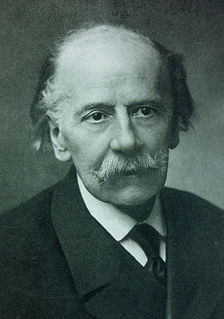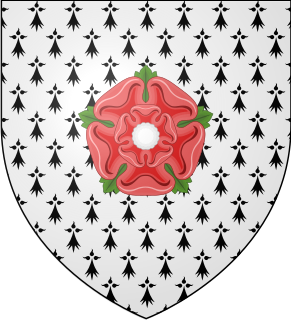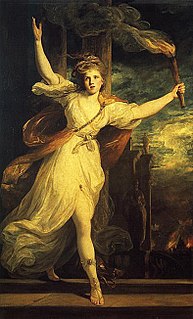
Sir Joshua Reynolds was an English painter, specialising in portraits. John Russell said he was one of the major European painters of the 18th century. He promoted the "Grand Style" in painting which depended on idealization of the imperfect. He was a founder and first president of the Royal Academy of Arts, and was knighted by George III in 1769.

Thomas Gainsborough was an English portrait and landscape painter, draughtsman, and printmaker. Along with his rival Sir Joshua Reynolds, he is considered one of the most important British artists of the second half of the 18th century. He painted quickly, and the works of his maturity are characterised by a light palette and easy strokes. Despite being a prolific portrait painter, Gainsborough gained greater satisfaction from his landscapes. He is credited as the originator of the 18th-century British landscape school. Gainsborough was a founding member of the Royal Academy.

Warren Hastings, an English statesman, was the first Governor of the Presidency of Fort William (Bengal), the head of the Supreme Council of Bengal, and thereby the first de facto Governor-General of Bengal from 1772 to 1785. He is credited along with Robert Clive for laying the foundation of the British Empire in India. He was an energetic organizer and reformer. In 1779–1784 he led the forces of the East India Company against a strong coalition of native states and the French. In the end, the well-organized British coalition held its own, while France lost her influence in India. In 1787, he was accused of corruption and impeached, but after a long trial he was acquitted in 1795. He was made a Privy Councillor in 1814.

George Romney was an English portrait painter. He was the most fashionable artist of his day, painting many leading society figures – including his artistic muse, Emma Hamilton, mistress of Lord Nelson.

The yakshas are a broad class of nature-spirits, usually benevolent, but sometimes mischievous or capricious, connected with water, fertility, trees, the forest, treasure and wilderness. They appear in Hindu, Jain and Buddhist texts, as well as ancient and medieval era temples of South Asia and Southeast Asia as guardian deities. The feminine form of the word is yakṣī or yakshini.

Hicky's Bengal Gazette or the Original Calcutta General Advertiser was an English language weekly newspaper published in Kolkata, the capital of British India. It was the first newspaper printed in Asia, and was published for two years, between 1780 and 1782, before the East India Company seized the newspaper's types and printing press. Founded by James Augustus Hicky, a highly eccentric Irishman who had previously spent two years in jail for debt, the newspaper was a strong critic of the administration of Governor General Warren Hastings. The newspaper was important for its provocative journalism and its fight for free expression in India.

Grace Dalrymple Elliott was a Scottish courtesan, writer and spy resident in Paris during the French Revolution. She was an eyewitness to events detailed in her memoirs, Journal of my life during the French Revolution published posthumously in 1859. She was mistress to the Duke of Orléans and to the future George IV, by whom she is said to have borne an illegitimate daughter. Elliott trafficked correspondence and hid French aristocrats escaping from the French Revolution. She was arrested several times but managed to avoid the guillotine, and was released after the death of Robespierre.

George James Cholmondeley, 1st Marquess of Cholmondeley,, styled Viscount Malpas between 1764 and 1770 and known as The Earl of Cholmondeley between 1770 and 1815, was a British peer and politician.

Philip Metcalfe,, , was an English Tory politician, a malt distiller and a philanthropist.

"Méditation" is a symphonic intermezzo from the opera Thaïs by French composer Jules Massenet. The piece is written for solo violin and orchestra. The opera premiered at the Opéra Garnier in Paris on March 16, 1894.

Hugh Boscawen, 1st Viscount Falmouth was a Cornish Whig politician who sat in the House of Commons for Cornish constituencies from 1702 until 1720 when he was raised to the peerage.

Arthur William Devis was an English painter of history paintings and portraits. He painted portraits and historical subjects, sixty-five of which he exhibited (1779–1821) at the Royal Academy. Among his more famous works are a depiction of the Death of Nelson and a posthumous portrait of Nelson.
HMS Hesper was a British Royal Navy 18-gun ship-sloop of the Cormorant class, launched in 1809 at Dartmouth. Her original builder, Benjamin Tanner, became bankrupt during her construction, so John Cock completed her. In 1810 she was reclassed as a 20-gun sixth rate ship ; in 1817 she was again re-rated, this time as 26 guns. She served primarily in the Indian Ocean. In 1810 she participated in the Invasion of Isle de France. The next year Hesper participated in the capture of Java, which she followed in 1812 by capturing Timor. She was sold in 1817.

Elizabeth Smith-Stanley, Countess of Derby was an English peeress. As the eligible eldest daughter of the 6th Duke of Hamilton, she married the 12th Earl of Derby in 1774, giving birth to three children. Lady Derby was popular among society and considered a leader of fashion alongside the Duchess of Devonshire.

Nancy was a schooner or ship launched at Bombay. In 1778 the British East India Company (EIC) government at Bengal acquired her to use as a warship at Calcutta. The EIC Board of Governors in London vetoed the idea and Nancy became an express packet ship. She made two voyages from Bengal to Ireland between 1782 and 1784, and was wrecked on the second of these.
John May built Mars at the naval dockyard at Amsterdam in 1769 as a fifth rate for the Dutch Navy. The British Royal Navy captured her on 3 February 1781 at Saint Eustatia. The Navy took her into service as HMS Mars, but sold her on 25 March 1784. Richard Bush purchased Mars, retained her name, and had her fitted as an East Indiaman. Adams repaired her and took her measurements in 1786. She sailed to China in April 1786 for the British East India Company (EIC) and was wrecked in December 1787 shortly after her return to Britain.

Anne Maynard or Anne, Viscountess Maynard; Anne Parsons; Nancy Parsons; Nancy Maynard; Mrs. Horton was a Kingdom of Great Britain successful courtesan and political mistress. She was de facto first lady, entertaining guests for her lover the Duke of Grafton, the First Minister.

Charles Shirreff was a deaf Scottish painter, specializing in portrait miniatures.

Thaïs is a portrait by Sir Joshua Reynolds of the English courtesan Emily Warren in the guise of the hetaera Thaïs, mistress of Alexander the Great. It is in oil on canvas and measures 229 x 145 cm. She holds a burning torch and with the other hand exhorts Alexander and his followers to burn down Persepolis. Reynolds exhibited it at the Royal Academy in London in 1781. It is now at Waddesdon Manor.
Nathaniel Middleton (1750–1807) was a civil servant of the British East India Company, closely involved with Warren Hastings and his dealings with the Nawab of Awadh during the 1770s, and later a principal witness at Hastings's trial.


















